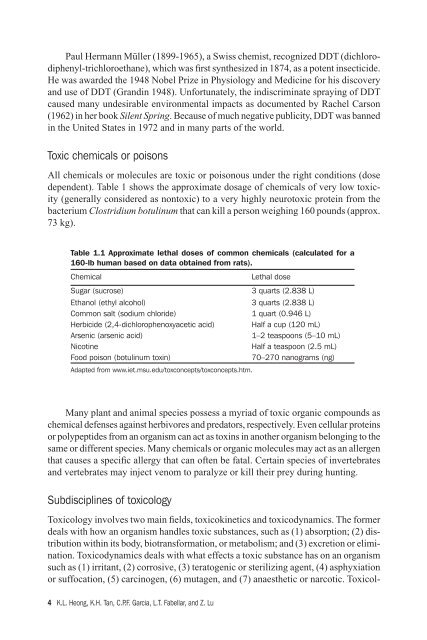Research Methods in Toxicology and Insecticide Resistance ...
Research Methods in Toxicology and Insecticide Resistance ...
Research Methods in Toxicology and Insecticide Resistance ...
You also want an ePaper? Increase the reach of your titles
YUMPU automatically turns print PDFs into web optimized ePapers that Google loves.
Paul Hermann Müller (1899-1965), a Swiss chemist, recognized DDT (dichlorodiphenyl-trichloroethane),<br />
which was fi rst synthesized <strong>in</strong> 1874, as a potent <strong>in</strong>secticide.<br />
He was awarded the 1948 Nobel Prize <strong>in</strong> Physiology <strong>and</strong> Medic<strong>in</strong>e for his discovery<br />
<strong>and</strong> use of DDT (Gr<strong>and</strong><strong>in</strong> 1948). Unfortunately, the <strong>in</strong>discrim<strong>in</strong>ate spray<strong>in</strong>g of DDT<br />
caused many undesirable environmental impacts as documented by Rachel Carson<br />
(1962) <strong>in</strong> her book Silent Spr<strong>in</strong>g. Because of much negative publicity, DDT was banned<br />
<strong>in</strong> the United States <strong>in</strong> 1972 <strong>and</strong> <strong>in</strong> many parts of the world.<br />
Toxic chemicals or poisons<br />
All chemicals or molecules are toxic or poisonous under the right conditions (dose<br />
dependent). Table 1 shows the approximate dosage of chemicals of very low toxicity<br />
(generally considered as nontoxic) to a very highly neurotoxic prote<strong>in</strong> from the<br />
bacterium Clostridium botul<strong>in</strong>um that can kill a person weigh<strong>in</strong>g 160 pounds (approx.<br />
73 kg).<br />
Table 1.1 Approximate lethal doses of common chemicals (calculated for a<br />
160-lb human based on data obta<strong>in</strong>ed from rats).<br />
Chemical Lethal dose<br />
Sugar (sucrose) 3 quarts (2.838 L)<br />
Ethanol (ethyl alcohol) 3 quarts (2.838 L)<br />
Common salt (sodium chloride) 1 quart (0.946 L)<br />
Herbicide (2,4-dichlorophenoxyacetic acid) Half a cup (120 mL)<br />
Arsenic (arsenic acid) 1–2 teaspoons (5–10 mL)<br />
Nicot<strong>in</strong>e Half a teaspoon (2.5 mL)<br />
Food poison (botul<strong>in</strong>um tox<strong>in</strong>) 70–270 nanograms (ng)<br />
Adapted from www.iet.msu.edu/toxconcepts/toxconcepts.htm.<br />
Many plant <strong>and</strong> animal species possess a myriad of toxic organic compounds as<br />
chemical defenses aga<strong>in</strong>st herbivores <strong>and</strong> predators, respectively. Even cellular prote<strong>in</strong>s<br />
or polypeptides from an organism can act as tox<strong>in</strong>s <strong>in</strong> another organism belong<strong>in</strong>g to the<br />
same or different species. Many chemicals or organic molecules may act as an allergen<br />
that causes a specifi c allergy that can often be fatal. Certa<strong>in</strong> species of <strong>in</strong>vertebrates<br />
<strong>and</strong> vertebrates may <strong>in</strong>ject venom to paralyze or kill their prey dur<strong>in</strong>g hunt<strong>in</strong>g.<br />
Subdiscipl<strong>in</strong>es of toxicology<br />
<strong>Toxicology</strong> <strong>in</strong>volves two ma<strong>in</strong> fi elds, toxicok<strong>in</strong>etics <strong>and</strong> toxicodynamics. The former<br />
deals with how an organism h<strong>and</strong>les toxic substances, such as (1) absorption; (2) distribution<br />
with<strong>in</strong> its body, biotransformation, or metabolism; <strong>and</strong> (3) excretion or elim<strong>in</strong>ation.<br />
Toxicodynamics deals with what effects a toxic substance has on an organism<br />
such as (1) irritant, (2) corrosive, (3) teratogenic or steriliz<strong>in</strong>g agent, (4) asphyxiation<br />
or suffocation, (5) carc<strong>in</strong>ogen, (6) mutagen, <strong>and</strong> (7) anaesthetic or narcotic. Toxicol-<br />
4 K.L. Heong, K.H. Tan, C.P.F. Garcia, L.T. Fabellar, <strong>and</strong> Z. Lu

















